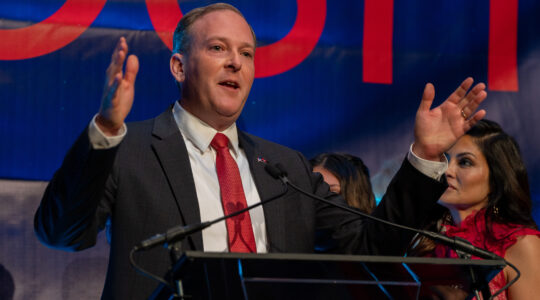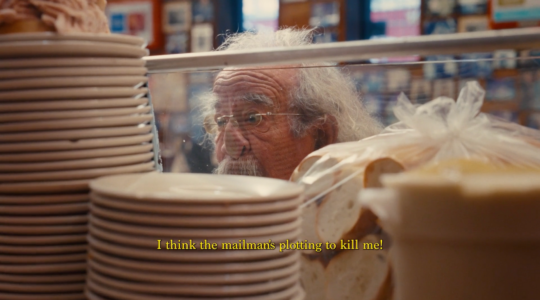For the first time, a son of Safed is prime minister. All right, so Mahmoud Abbas (Abu Mazen) is the Palestinian prime minister, but Israelís fate is in his hands as much as anyoneís. When he insists that peace depends on Israel recognizing the Arab right of return, heís talking about himself and heís talking about Safed.
As Abu Mazen tells it, according to a media blitz spanning every continent, he was forced to flee Safed as a child of 13, along with 10,000 other Arabs, during the 1947-48 fighting that led to Israelís independence. Safed was a quaint agricultural town, a donkey ride from the Syrian border. His father had a flock of sheep whose milk was made into cheese, and the family sold nuts
and vegetables from their window. A yeshiva now stands on the ruins of his home. All he might recognize is the old cypress tree in the yard.
Abu Mazen snuck back, incognito, in 1994 to see Safed one more time, to see his lost paradise, to see how Palestinian homes were turned into art studios and gallery space. Friends say his sense of loss and longing has not faded with time.
Thatís what Safed means to Abu Mazen.
Perhaps it means something to you. Jews left as refugees, too. The mother of Jacob Javits, the late New York senator, fled Safed as a 19-year-old after Arab pogroms. Generations of the Javits family are buried on the hillside cemetery, a repository of 100,000 souls whose stones read like a history primer. Here within the borders of the Tribe of Naftali rests the Prophet Hosea; Hannah and her seven sons from the Chanukah story; Yitzhak Luria, 16th century founder of ìmodernî kabbalism; Shlomo Alkabetz, author of Lecha Dodi; Joseph Caro, author of the Shulchan Aruch code of Jewish law and ancestor of another New Yorker, Pulitzer Prize-winning historian Robert Caro; Dov Gruner and six others of the Jewish underground hung by the British in Acre, 1947; and a Safed class of 11th-graders who in 1974 were massacred while they slept in nearby Maalot during a class trip.
After decades in which Jewish leaders funneled dreams of restoration and settlement through a West Bank prism, the forthcoming Palestinian state on the West Bank is leading the Israeli government to try and focus Jewish spiritual and pioneering spirit elsewhere. Safed may be the winner. After all, according to Jewish rabbinic tradition, Safed (pronounced Tzfat in Hebrew), like Hebron, is one of Israelís four designated holy cities except, unlike Hebron, Safed is entirely Jewish (pop. 25,000). The government has settled 6,000 emigres from the former Soviet Union and Ethiopia in Safed, and recently announced a $40 million grant, matching the $40 million committed by the nonprofit Safed Foundation, for synagogue preservation (Safed has several of Israelís oldest synagogues in continuous use); cemetery restoration; establishment of an international center for kabbalah studies; revitalization of the artists colony; restoration of parks and open spaces; and development of educational and cultural programs.
After years of essentially ignoring Safed, Prime Minister Ariel Sharon recently declared, ìSafed has long deserved to be at the center of promotional and development efforts in the Galilee.î
The quest to establish ìfacts on the groundî has now shifted to the Galilee, where there are several districts that already have a considerable Arab majority, according to the Israeli government. Arabs comprise 18.6 percent of Israelís population, but 46 percent of northern Israel, and many say a clear Galilee majority helped by 50,000 Arab ìsettlers,î as some call them, from the nearby West Bank. Many predict that the Galilee Arabs will want political autonomy of their own. By what right does a Jewish government rule over an Arab majority in the Galilee any more than over an Arab majority on the West Bank?
Binyamin Shalev, director of The Safed Foundation, told The Jewish Week, ìIf Jews are not going to live in the Galil,î the regionís Hebrew name, ìthen we have to visit the Galil. Spend a night here, spend some money here, so Jews here can be employed. If we donít invest in the Galil, weíre going to lose the Galil.î
In the past century, local Arabs put up a sporadic but fierce fight for the Galilee. Jews fled by the thousands after Arab pogroms in 1929, an Arab intifada of 1936-39 and a deadly five-month siege of the Safed Jewish community in 1948, before the siege was fought off by Jewish fighters, inspiring thousands of Arabs to flee in fear of Jewish retribution ó Abu Mazenís family among them.
Shalev, known also by his pre-aliyah name of Binny Shudofsky, describes Safed as a ìpoor city.î
ìUnemployment is at 10 percent. Thereís no industry to speak of. Creating a tourism infrastructure is in many ways the very future of this town,î he said.
But Safed has become a marginal destination, with most tourism coming from other Israelis. Without tourists, the once legendary artists colony has become dormant and neglected. Shalev says that Safed has ìan image problem.î
ìItís considered a haredi town,î with 40 percent fervently Orthodox, mostly chasidim. Some artists, Shalev says, donít want to live in a town without cafes that are open Friday night. ìWeíre trying to get American investors to buy homes in the artists colony, then making the homes available for artists-in-residence programs.î
Safed has established an annual klezmer festival and weekly musical programs on Friday afternoons to broaden then townís cultural base and associations. The government is also establishing an educational program for Israeli soldiers there, with a Shabbat experience and explorations into the townís military history. This way, soldiers might have a better idea about what they are fighting for and those who have fought before.
Those tourists who do come, as any visitor will easily tell, discover a mountain town so hauntingly beautiful as to immediately explain its magnetism for the great kabbalists in the 1500s. It was here where in a burst of creativity perhaps unparalleled in Jewish history, a group of mystics in the circle of Rabbi Luria (known as the Ari) fashioned the Friday-evening Kabbalat Shabbat service, the Tu bíShvat seder and Tikkun Leil Shavuotís tradition of all-night study. The Ashkenaz-Ari synagogue is on the site where, in an open field, kabbalists dressed in white gathered to watch the Friday sun go down over the western hills before welcoming Shabbat with meditation, dance and song. Among this inspired group were the authors of Lecha Dodi and Yedid Nefesh.
The reason Jews turn to face the back of the shul at the end of Lecha Dodi, explains Shalev, came about because in Safed all the synagogue doors face West, toward Mount Meron, the burial place of Shimon Bar-Yochai, the mystic most associated with the Zohar. To open the doors, says Shalev, was a way of welcoming the Messiah that Bar-Yocahi foretold.
Near these famous fields is the ethereal and medicinal mikveh of the Ari, where he would immerse in a natural stone pool filled with freezing mountain water gushing from a crack in the mountain wall. The Safed Foundation is building an adjacent womenís mikveh that will use the same water source.
A question remains: Who wants Safed more, Abu Mazen or you?
The New York Jewish Week brings you the stories behind the headlines, keeping you connected to Jewish life in New York. Help sustain the reporting you trust by donating today.




